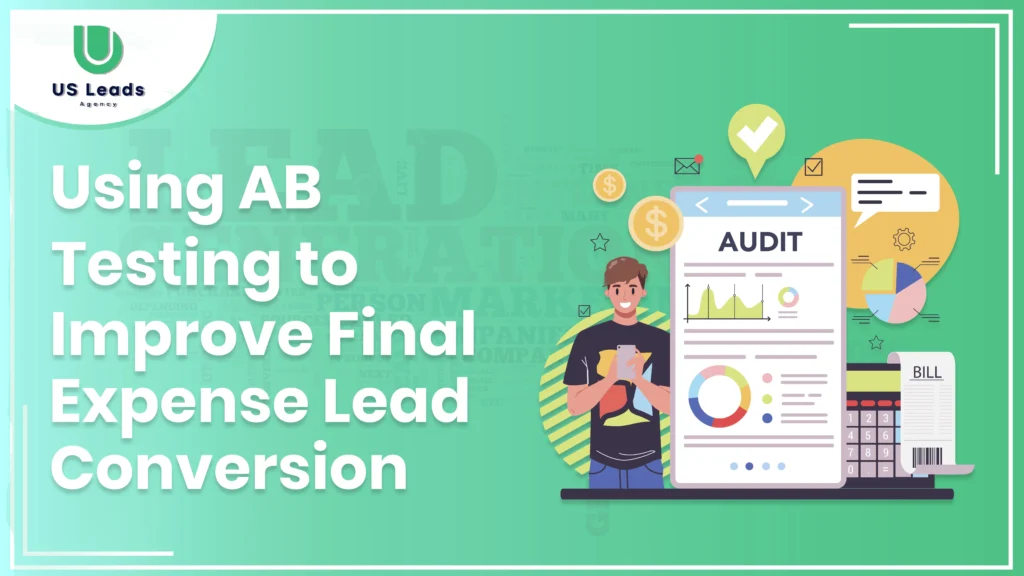
Final expense insurance is a competitive market where every conversion counts. A/B testing, or split testing, allows agencies to make data-driven decisions by comparing variations of marketing elements to identify what resonates most with their target audience. This approach improves final expense lead generation, optimizes campaigns, and increases conversions.
In this article, we’ll explore actionable strategies for using A/B testing for final expense lead conversion.
Key Takeaways:
- Data-Driven Optimization: A/B testing refines marketing elements for better results.
- Increased Conversions: Test headlines, CTAs, and visuals to boost performance.
- Reduced Costs: Lower CPA by focusing on high-performing variations.
- Key Testing Areas: Landing pages, ad campaigns, email marketing, and call scripts.
- Continuous Improvement: Analyze results and iterate for ongoing success.
Table of Contents
What is A/B Testing?
A/B testing, or split testing, is a method of comparing two or more versions of a marketing element to determine which performs better. One version acts as the control, while the other introduces changes. Metrics such as click-through rates (CTR), conversion rates, and engagement levels guide decisions.
For final expense insurance, A/B testing can optimize:
- Landing pages
- Ad campaigns
- Email content
- Call-to-action (CTA) buttons
- Call scripts
Why Use A/B Testing For Final Expense Lead Conversion?
1. Gain Audience Insights:
Understand preferences for messaging, visuals, and offers tailored to seniors.
2. Boost Conversion Rates:
Small adjustments, like tweaking a headline or button color, can lead to measurable improvements.
3. Lower Cost Per Acquisition (CPA):
Optimize campaigns to maximize results without increasing the budget.
4. Make Data-Driven Decisions:
Replace guesswork with actionable insights, ensuring strategies are based on evidence.
Key Areas To Apply A/B Testing:
1. Landing Pages:
- Headlines: Test variations to determine what grabs attention (e.g., “Affordable Final Expense Coverage” vs. “Secure Peace of Mind for Your Loved Ones”).
- Forms: Adjust the number of required fields to reduce friction.
- CTAs: Compare “Get a Free Quote” vs. “Learn About Your Options.”
- Design: Experiment with layouts, colors, and trust indicators like badges or testimonials.
2. Ad Campaigns:
- Ad Copy: Compare emotional appeals (e.g., “Protect Your Family’s Future”) to factual messaging (e.g., “No Medical Exam Required”).
- Visuals: Test static images, videos, or infographic-style ads.
- Offers: Evaluate different promotions, such as “Affordable Rates for Seniors” or “Exclusive Final Expense Leads.”
3. Email Marketing:
- Subject Lines: Use curiosity-driven (e.g., “Are You Covered?”) or urgency-driven (e.g., “Don’t Miss Out on Savings”) approaches.
- Body Content: Compare concise formats to detailed explanations.
- CTAs: Test buttons like “Get a Quote Now” against “Explore Your Options.”
4. Call Scripts:
- Openers: Test greetings like “Hi, this is [Name], how can I help you today?” vs. “Hi, are you interested in affordable final expense insurance?”
- Benefits Highlighted: Compare focusing on affordability vs. comprehensive coverage.
- Closings: Experiment with urgency-driven closes (e.g., “Act now to lock in this rate”) vs. relationship-focused ones.
How To Implement A/B Testing Effectively?
- Define Clear Goals: Focus on metrics like form submissions, CTR, or reduced bounce rates.
- Test One Variable at a Time: Avoid confusion by isolating individual changes.
- Use Reliable Tools: Platforms like Google Optimize or Mailchimp streamline testing.
- Run Tests Long Enough: Allow for statistically significant results (typically 1–2 weeks).
- Analyze and Iterate: Apply insights from winning variations and refine further.
Case Study: A/B Testing Success
A final expense agency conducted A/B testing on their landing page:
- Version A (Control): Headline: “Affordable Final Expense Insurance.”
- Version B (Test): Headline: “Protect Your Loved Ones with Affordable Coverage.”
Results: Version B increased form submissions by 27%. Additionally, changing the CTA button color from red to green improved conversions by 15%.
This highlights the value of even small, data-driven adjustments.
Conclusion – A/B Testing For Final Expense Lead Conversion:
A/B testing is an indispensable tool for optimizing final expense lead conversion. By systematically testing and refining landing pages, ad campaigns, email strategies, and call scripts, agencies can achieve higher conversion rates and lower CPA. With a commitment to continuous improvement, A/B testing ensures your marketing efforts remain effective in a competitive landscape.
Start small, analyze the results, and iterate for long-term success in generating exclusive final expense leads.
FAQs:
Can A/B testing improve ROI?
Yes, by identifying high-performing variations, A/B testing enhances ROI by reducing wasted spending.
How long should I run an A/B test?
Run tests for 1–2 weeks or until you achieve statistically significant results.
Why is A/B testing important for final expense leads?
It identifies effective strategies, boosts conversions, and lowers costs.
